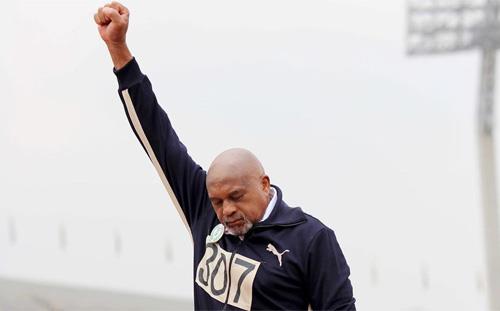
A good documentary can be both troubling and hopeful, and that describes With Drawn Arms, a film about the life of Olympic gold medalist Tommie Smith.
With Drawn Arms, which which has its world premiere Monday on the Bounce network (and will also be available for streaming on Starz and Hulu), tracks the most famous raised fist in modern American history – the gloved right hand raised by Smith on the podium after winning the 200 meters at the 1968 Olympic Games in Mexico City.
Smith's gesture, he said then, and he repeats here, was intended to acknowledge and challenge the discrimination faced by Black Americans.
With Drawn Arms argues that the impact of the gesture ripples up to the present day, through Colin Kaepernick, Megan Rapinoe, LeBron James, and other athletes who use their visibility to point out areas where America still falls short.
Directed by Glenn Kaino and Afshin Shahidi and produced by John Legend and Jesse Williams, the documentary also delves into the decades-long price Smith paid for a silent gesture that lasted exactly as long as it took to play the U.S. National Anthem.
Sent home from Olympic Village by the Olympics' hard-line boss Avery Brundage, Smith soon realized his athletic career was essentially over, and he was almost unemployable.
The one job he could find was washing cars at a Pontiac dealership, where he would be summoned to the showroom periodically so customers could say they had met an Olympic gold medalist.
He married twice, had five children, and divorced twice. While With Drawn Arms doesn't dwell on those years, it's evident that drinking and anger became problems.
The backlash against his gesture – in which he was joined by John Carlos, who won the bronze medal in the same race – began as the athletes were leaving the stadium, when booing was heard from the stands.
Smith and several commentators, including journalist Nelson George and the late Rep. John Lewis, explain the context of the times.
The civil rights movement was at a crossroads after the assassinations of Rev. Martin Luther King Jr. and Malcolm X. Black athletes had seriously discussed boycotting the Olympics altogether, ultimately deciding that protesting in any form should be an individual decision.
Smith says he saw the raised fist sending a message of solidarity, and Lewis, among others, says that's how it was widely received in the Black community.
Some other communities saw it as unpatriotic and, quite possibly, menacing. The raised fist was often identified in 1968 with the Black Panther Party, which had a reputation for militance and which law enforcement agencies like the FBI were working to demonize.
Co-director Kaino plays a prominent role in the film through his collaboration with Smith on an Atlanta museum exhibition, also titled With Drawn Arms, that turns images from Smith's gesture into artworks.
Kaino calls Smith's gesture "a kind of performance art," which makes sense in Kaino's art world though it could tend to trivialize it for some viewers in the larger context.
The compelling story here is that a Black athlete used the Olympic platform to call attention to the indisputable fact that America had long been deficient in civil rights. For years afterward, he was punished, and so was his family. His mother received hate mail and vile packages, Smith says, and he remains convinced that level of stress helped lead to her eventual fatal heart attack.
Weighing the cost against the positive impact of the raised fist does not ultimately feel possible. Lewis, among others, hails both the gesture and the sacrifice, saying it spoke for millions with no voice and served as one more step in the long march toward a more decent world.
Viewers will get the sense that all these years later, Smith has won more respect. He also won some victories. He found work as a track coach, from which he now seems comfortably retired. He was inducted into the U.S. Olympic Hall of Fame, which is probably as close to an apology as he could expect. He had a cordial chat at the White House with then-President Barack Obama, and he made the front of a Wheaties box, albeit in a limited edition of one.
For whatever reason, With Drawn Arms doesn't include comments from a number of people connected to the story. That includes Carlos, who continued his track career after 1968 and went to work for the U.S. Olympic Committee. It also includes Smith's children. From his family, only his third wife, Delois, appears extensively.
All that may be deliberate, to keep the focus of With Drawn Arms on the raised fist and its impact on the rest of Tommie Smith's life.
While that impact was clearly mixed, Smith firmly asserts he has no second thoughts. The only thing he regrets about the gesture, he says, "is that it was necessary."